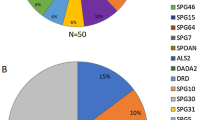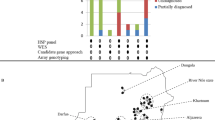Abstract
Hereditary spastic paraplegias (HSP) are the second most common type of motor neuron disease recognized worldwide. We investigated a total of 25 consanguineous families from Sudan. We used next-generation sequencing to screen 74 HSP-related genes in 23 families. Linkage analysis and candidate gene sequencing was performed in two other families. We established a genetic diagnosis in six families with autosomal recessive HSP (SPG11 in three families and TFG/SPG57, SACS and ALS2 in one family each). A heterozygous mutation in a gene involved in an autosomal dominant HSP (ATL1/SPG3A) was also identified in one additional family. Six out of seven identified variants were novel. The c.64C>T (p.(Arg22Trp)) TFG/SPG57 variant (PB1 domain) is the second identified that underlies HSP, and we demonstrated its impact on TFG oligomerization in vitro. Patients did not present with visual impairment as observed in a previously reported SPG57 family (c.316C>T (p.(Arg106Cys)) in coiled-coil domain), suggesting unique contributions of the PB1 and coiled-coil domains in TFG complex formation/function and a possible phenotype correlation to variant location. Some families manifested marked phenotypic variations implying the possibility of modifier factors complicated by high inbreeding. Finally, additional genetic heterogeneity is expected in HSP Sudanese families. The remaining families might unravel new genes or uncommon modes of inheritance.
Similar content being viewed by others
Log in or create a free account to read this content
Gain free access to this article, as well as selected content from this journal and more on nature.com
or
References
Tesson C, Koht J, Stevanin G : Delving into the complexity of hereditary spastic paraplegias: how unexpected phenotypes and inheritance modes are revolutionizing their nosology. Hum Genet 2015; 134: 511–538.
Fink J : Hereditary spastic paraplegia overview. In: Pagon R, Adam M, Ardinger H et al: (eds): GeneReviews. University of Washington: Seattle (WA), USA, 1993. Available at: http://www.ncbi.nlm.nih.gov/books/NBK1509/.
Schmitz-Hübsch T, Klockgether T : An update on inherited ataxias. Curr Neurol Neurosci Rep 2008; 8: 310–319.
Finsterer J : Ataxias with autosomal, X-chromosomal or maternal inheritance. Can J Neurol Sci 2009; 36: 409–428.
Coutelier M, Stevanin G, Brice A : Genetic landscape remodelling in spinocerebellar ataxias: the influence of next-generation sequencing. J Neurol 2015; 262: 2382–2395.
Noreau A, Dion P, Rouleau G : Molecular aspects of hereditary spastic paraplegia. Exp Cell Res 2014; 325: 18–26.
Ruano L, Melo C, Silva M, Coutinho P : The global epidemiology of hereditary ataxia and spastic paraplegia: a systematic review of prevalence studies. Neuroepidemiology 2014; 42: 174–183.
Finsterer J, Löscher W, Quasthoff S, Wanschitz J, Auer-Grumbach M, Stevanin G : Hereditary spastic paraplegias with autosomal dominant, recessive, x-linked, or maternal trait of inheritance. J Neurol Sci 2012; 318: 1–18.
Coutinho P, Barros J, Zemmouri R et al: Clinical heterogeneity of autosomal recessive spastic paraplegias: analysis of 106 patients in 46 families. Arch Neurol 1999; 56: 943–949.
Boukhris A, Stevanin G, Feki I et al: Hereditary spastic paraplegia with mental impairment and thin corpus callosum in tunisia: SPG11, SPG15, and further genetic heterogeneity. Arch Neurol 2008; 65: 393–402.
França M, D’Abreu A, Maurer-Morelli C et al: Prospective neuroimaging study in hereditary spastic paraplegia with thin corpus callosum. Mov Disord 2007; 22: 1556–1562.
Stevanin G, Santorelli F, Azzedine H et al: Mutations in SPG11, encoding spatacsin, are a major cause of spastic paraplegia with thin corpus callosum. Nat Genet 2007; 39: 366–372.
Shibasaki Y, Tanaka H, Iwabuchi K et al: Linkage of autosomal recessive hereditary spastic paraplegia with mental impairment and thin corpus callosum to chromosome 15A13-15. Ann Neurol 2000; 48: 108–112.
Casali C, Valente E, Bertini E et al: Clinical and genetic studies in hereditary spastic paraplegia with thin corpus callosum. Neurology 2004; 62: 262–268.
Stevanin G, Montagna G, Azzedine H et al: Spastic paraplegia with thin corpus callosum: description of 20 new families, refinement of the SPG11 locus, candidate gene analysis and evidence of genetic heterogeneity. Neurogenetics 2006; 7: 149–156.
Schüle R, Schlipf N, Synofzik M et al: Frequency and phenotype of SPG11 and SPG15 in complicated hereditary spastic paraplegia. J Neurol Neurosurg Psychiatry 2009; 80: 1402–1404.
Novarino G, Fenstermaker A, Zaki M et al: Exome sequencing links corticospinal motor neuron disease to common neurodegenerative disorders. Science 2014; 343: 506–511.
Beetz C, Johnson A, Schuh A et al: Inhibition of TFG function causes hereditary axon degeneration by impairing endoplasmic reticulum structure. Proc Natl Acad Sci USA 2013; 110: 5091–5096.
Ishiura H, Sako W, Yoshida M et al: The TRK-fused gene is mutated in hereditary motor and sensory neuropathy with proximal dominant involvement. Am J Hum Genet 2012; 91: 320–329.
Takiyama Y : Sacsinopathies: sacsin-related ataxia. Cerebellum 2007; 6: 353–359.
Gregianin E, Vazza G, Scaramel E et al: A novel SACS mutation results in non-ataxic spastic paraplegia and peripheral neuropathy. Eur J Neurol 2013; 20: 1486–1491.
Synofzik M, Soehn A, Gburek-Augustat J et al: Autosomal recessive spastic ataxia of charlevoix saguenay (ARSACS): expanding the genetic, clinical and imaging spectrum. Orphanet J Rare Dis 2013; 8: 41.
Yang Y, Hentati A, Deng H : The gene encoding Alsin, a protein with three guanine-nucleotide exchange factor domains, is mutated in a form of recessive amyotrophic lateral sclerosis. Nat Genet 2001; 29: 160–165.
Salih M : Genetic disorders in Sudan. In: Teebi AS (eds): Genetic Disorders Among Arab Populations, 2nd edn. Springer Science & Business Media, Springer-Verlag Berlin Heidelberg: Germany, 2010, pp 575–612.
de Bot S, Burggraaff R, Herkert J et al: Rapidly deteriorating course in Dutch hereditary spastic paraplegia type 11 patients. EJHG 2013; 21: 1312–1315.
Denora P, Muglia M, Casali C et al: Spastic paraplegia with thinning of the corpus callosum and white matter abnormalities: further mutations and relative frequency in ZFYVE26/SPG15 in the Italian population. J Neurol Sci 2009; 277: 22–25.
Abdel-Aleem A, Abu-Shahba N, Swistun D et al: Expanding the clinical spectrum of SPG11 gene mutations in recessive hereditary spastic paraplegia with thin corpus callosum. Eur J Med Genet 2011; 54: 82–85.
Baets J, Deconinck T, Smets K : Mutations in SACS cause atypical and late-onset forms of ARSACS. Neurology 2010; 75: 1181–1188.
El Euch-Fayache G, Lalani I, Amouri R et al: Phenotypic features and genetic findings in sacsin-related autosomal recessive ataxia in Tunisia. Arch Neurol 2003; 60: 982–988.
Criscuolo C, Banfi S, Orio M et al: A novel mutation in SACS gene in a family from Southern Italy. Neurology 2004; 62: 100–102.
Grieco G, Malandrini A, Comanducci G et al: Novel SACS mutations in autosomal recessive spastic ataxia of charlevoix-saguenay type. Neurology 2004; 62: 103–106.
Ogawa T, Takiyama Y, Sakoe K et al: Identification of a SACS gene missense mutation in ARSACS. Neurology 2014; 62: 107–109.
Hedera P : Spastic paraplegia 3A. In: Pagon R, Adam M, Ardinger H et al: (eds): GeneReviews. University of Washington: Seattle (WA), USA, 1993. Available at: http://www.ncbi.nlm.nih.gov/books/NBK45978/.
Eymard-Pierre E, Lesca G, Dollet S et al: Infantile-onset ascending hereditary spastic paralysis is associated with mutations in the Alsin gene. Am J Hum Genet 2002; 71: 518–527.
Devon R, Helm J, Rouleau G et al: The first nonsense mutation in Alsin results in a homogeneous phenotype of infantile-onset ascending spastic paralysis with bulbar involvement in two siblings: first nonsense mutation in Alsin. Clin Genet 2003; 64: 210–215.
Wakil S, Ramzan K, Abuthuraya R et al: Infantile-onset ascending hereditary spastic paraplegia with bulbar involvement due to the novel ALS2 mutation c.2761C>T. Gene 2014; 536: 217–220.
Lamark T, Perander M, Outzen H et al: Interaction codes within the family of mammalian Phox and Bem1p domain-containing proteins. J Biol Chem 2003; 278: 34568–34581.
Johnson A, Bhattacharya N, Hanna M et al: TFG clusters COPII-coated transport carriers and promotes early secretory pathway organization. EMBO J 2015; 34: 811–827.
Schabhüttl M, Wieland T, Senderek J et al: Whole-exome sequencing in patients with inherited neuropathies: outcome and challenges. J Neurol 2014; 261: 970–982.
Acknowledgements
We thank the members of the DNA and cell bank of the ICM, Federica Barreca, Emeline Mundwiller, Khalid El Hachimi and Delphine Bouteiller for their valuable contribution. This study was supported financially by the Agence Nationale de la Recherche (SPATAX-QUEST project, to Giovanni Stevanin), the Verum Foundation and Roger de Spoelberg Foundation (to Alexis Brice), the European Union (Neuromics projects, OMICS call, to Alexis Brice, Alexandra Durr and Giovanni Stevanin) and the National Institutes of Health (GM110567 to Anjon Audhya) and benefited from the Programme d’Investissement d’Avenir IHU-A-ICM. Liena Elsayed was the recipient of a Campus France and University of Khartoum fellowships.
Author information
Authors and Affiliations
Corresponding authors
Ethics declarations
Competing interests
The authors declare no conflict of interest.
Additional information
Supplementary Information accompanies this paper on European Journal of Human Genetics website
Rights and permissions
About this article
Cite this article
Elsayed, L., Mohammed, I., Hamed, A. et al. Hereditary spastic paraplegias: identification of a novel SPG57 variant affecting TFG oligomerization and description of HSP subtypes in Sudan. Eur J Hum Genet 25, 100–110 (2017). https://doi.org/10.1038/ejhg.2016.108
Received:
Revised:
Accepted:
Published:
Issue date:
DOI: https://doi.org/10.1038/ejhg.2016.108
This article is cited by
-
Experience in the clinical and genetic diagnosis of a series of Algerian patients with hereditary spastic paraplegias
Neurogenetics (2025)
-
Clinical phenotyping and genetic diagnosis of a large cohort of Sudanese families with hereditary spinocerebellar degenerations
European Journal of Human Genetics (2024)
-
Consanguinity and willingness to perform premarital genetic screening in Sudan
European Journal of Human Genetics (2023)
-
Power of NGS-based tests in HSP diagnosis: analysis of massively parallel sequencing in clinical practice
neurogenetics (2023)
-
A review of the genetic spectrum of hereditary spastic paraplegias, inherited neuropathies and spinal muscular atrophies in Africans
Orphanet Journal of Rare Diseases (2022)



